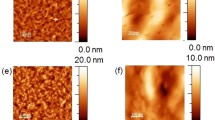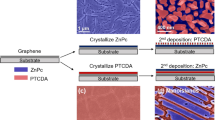Abstract
As dipyranylidenes are excellent hole carriers, applications in organic solar cells or organic light emitting diode are envisaged. In the present study, we investigate the morphology of 2,2′,6,6′-tetraphenyl-4,4′-dipyranylidene (DIPO-Ph4) deposited under vacuum on a silicon nitride (Si3N4) substrate, a paradigmatic system for the study of molecular crystal/inorganic substrate interfaces. Samples with various coating ratios and different thermal treatments were prepared. The films were characterized by atomic force microscopy and scanning transmission X-ray microscopy to gain insight into material growth. The results show a change in orientation at a molecular level depending upon the evaporation conditions. We are now able to tailor an organic layer with a specific molecular orientation and a specific electronic behavior.

Similar content being viewed by others
References
Li, S. S.; Ye, L.; Zhao, W. C.; Zhang, S. Q.; Mukherjee, S.; Ade, H.; Hou, J. H. Energy-level modulation of smallmolecule electron acceptors to achieve over 12% efficiency in polymer solar cells. Adv. Mater. 2016, 28: 9423–9429.
Zhao, J. B.; Li, Y. K.; Yang, G. F.; Jiang, K.; Lin, H. R.; Ade, H.; Ma, W.; Yan, H. Efficient organic solar cells processed from hydrocarbon solvents. Nat. Energy 2016, 1: 15027.
Yan, Y.; Liu, X.; Wang, T. Conjugated-polymer blends for organic photovoltaics: Rational control of vertical stratification for high performance. Adv. Mater. 2017, 29: 1601674.
Lin, Y. Z.; Chen, B.; Zhao, F. W.; Zheng, X. P.; Deng, Y. H.; Shao, Y. C.; Fang, Y. J.; Bai, Y.; Wang, C. R.; Huang, J. S. Matching charge extraction contact for wide-bandgap perovskite solar cells. Adv. Mater. 2017, 29: 1700607.
Yue, S. Z.; Lu, S. D.; Ren, K. K.; Liu, K.; Azam, M.; Cao, D. W.; Wang, Z. J.; Lei, Y.; Qu, S. C.; Wang, Z. G. Insights into the influence of work functions of cathodes on efficiencies of perovskite solar cells. Small 2017, 13: 1700007.
Atxabal, A.; Braun, S.; Arnold, T.; Sun, X. N.; Parui, S.; Liu, X J..; Gozalvez, C.; Llopis, R.; Mateo-Alonso, A.; Casanova, F. et al. Energy level alignment at metal/solutionprocessed organic semiconductor interfaces. Adv. Mater. 2017, 29: 1606901.
Yao, H. F.; Cui, Y.; Yu, R. N.; Gao, B. W.; Zhang, H.; Hou, J. H. Design, synthesis, and photovoltaic characterization of a small molecular acceptor with an ultra-narrow band gap. Angew. Chem., Int. Ed. 2017, 56: 3045–3049.
Giebink, N. C.; Wiederrecht, G. P.; Wasielewski, M. R.; Forrest, S. R. Thermodynamic efficiency limit of excitonic solar cells. Phys. Rev. B 2011, 83: 195326.
Yeo, J. S.; Yun, J. M.; Kang, M. J.; Khim, D.; Lee, S. H.; Kim, S. S.; Na, S. I.; Kim, D. Y. An approach for an advanced anode interfacial layer with electron-blocking ability to achieve high-efficiency organic photovoltaics. ACS Appl. Mater. Interfaces 2014, 6: 19613–19620.
Irwin, M. D.; Buchholz, D. B.; Hains, A. W.; Chang, R. P. H.; Marks, T. J. P-type semiconducting nickel oxide as an efficiency-enhancing anode interfacial layer in polymer bulk-heterojunction solar cells. Proc. Natl. Acad. Sci. USA 2008, 105: 2783–2787.
Zeng, H.; Zhu, X. C.; Liang, Y. Y.; Guo, X. G. Interfacial layer engineering for performance enhancement in polymer solar cells. Polymers 2015, 7: 333–372.
Berny, S.; Tortech, L.; Véber, M.; Fichou, D. Dithiapyrannylidenes as efficient hole collection interfacial layers in organic solar cells. ACS Appl. Mater. Interfaces 2010, 2: 3059–3068.
Watts, B.; Schuettfort, T.; McNeill, C. R. Mapping of domain orientation and molecular order in polycrystalline semiconducting polymer films with soft X-ray microscopy. Adv. Funct. Mater. 2011, 21: 1122–1131.
Bartelt, J. A.; Beiley, Z. M.; Hoke, E. T.; Mateker, W. R.; Douglas, J. D.; Collins, B. A.; Tumbleston, J. R.; Graham, K. R.; Amassian, A.; Ade, H. et al. The importance of fullerene percolation in the mixed regions of polymer-fullerene bulk heterojunction solar cells. Adv. Energy Mater. 2013, 3: 364–374.
Collins, B. A.; Li, Z.; Tumbleston, J. R.; Gann, E.; McNeill, C. R.; Ade, H. Absolute measurement of domain composition and nanoscale size distribution explains performance in PTB7:PC71 BM solar cells. Adv. Energy Mater. 2013, 3: 65–74.
Stuart, A. C.; Tumbleston, J. R.; Zhou, H. X.; Li, W. T.; Liu, S. B.; Ade, H.; You, W. Fluorine substituents reduce charge recombination and drive structure and morphology development in polymer solar cells. J. Am. Chem. Soc. 2013, 135: 1806–1815.
Ye, L.; Zhang, S. Q.; Ma, W.; Fan, B. H.; Guo, X.; Huang, Y.; Ade, H.; Hou, J. H. From binary to ternary solvent: Morphology fine-tuning of D/A blends in PDPP3T-based polymer solar cells. Adv. Mater. 2012, 24: 6335–6341.
Swaraj, S.; Wang, C.; Yan, H. P.; Watts, B.; Lüning, J.; McNeill, C. R.; Ade, H. Nanomorphology of bulk heterojunction photovoltaic thin films probed with resonant soft X-ray scattering. Nano Lett. 2010, 10: 2863–2869.
Collins, B. A.; Cochran, J. E.; Yan, H.; Gann, E.; Hub, C.; Fink, R.; Wang, C.; Schuettfort, T.; McNeill, C. R.; Chabinyc, M. L. et al. Polarized X-ray scattering reveals non-crystalline orientational ordering in organic films. Nat. Mater. 2012, 11: 536–543.
Collins, B. A.; Gann, E.; Guignard, L.; He, X. X.; McNeill, C. R.; Ade, H. Molecular miscibility of polymer-fullerene blends. J. Phys. Chem. Lett. 2010, 1: 3160–3166.
Chasseau, D.; Gaultier, J.; Hauw, C.; Fugnitto, R.; Gianis, V.; Strzelecka, H. Tétraphényldipyranylidène (Dip φ4). Acta Cryst. 1982, 38: 1629–1631.
Fichou, D.; Tortech, L.; Alaaeddine, M. Novel method for manufacturing organic electronic devices. U.S. Patent 2015280125 (A1), October 1, 2015.
Pál, L.; Grüner, G.; Jánossy, A.; Sólyom, J. Organic Conductors and Semiconductors; Springer: Berlin, Heidelberg, 1977.
D’Andrade, B. W.; Datta, S.; Forrest, S. R.; Djurovich, P.; Polikarpov, E.; Thompson, M. E. Relationship between the ionization and oxidation potentials of molecular organic semiconductors. Org. Electron. 2005, 6: 11–20.
Barth, V. Dipyrrométhènes métallés (Co, Ni, Cu) et dipyrannilidènes: De nouveaux materiaux organiques pour la conversion photovoltaïque de l’energie solaire. Ph.D. Dissertation, Université Pierre et Marie Curie, Paris, French, 2014.
Berny, S.; Tortech, L.; Fichou, D. Dérivés de type dipyrannylidene comme couche interfaciale anodique dans des dispositifs électroniques. WO/2011/045478, 2009.
aXis2000 sourceai][Online]. http://unicorn.mcmaster.ca/ aXis2000.html (accessed May 2, 2017).
Stöhr, J. NEXAFS Spectroscopy; Springer: Berlin Heidelberg, 1992.
Liu, L. H.; Michalak, D. J.; Chopra, T. P.; Pujari, S. P.; Cabrera, W.; Dick, D.; Veyan, J. F.; Hourani, R.; Halls, M. D.; Zuilhof, H. et al. Surface etching, chemical modification and characterization of silicon nitride and silicon oxide— selective functionalization of Si3N4 and SiO2. J. Phys. Condens. Matter 2016, 28: 094014.
Venables, J. A.; Spiller, G. D. T.; Hanbucken, M. Nucleation and growth of thin films. Reports Prog. Phys. 1984, 47: 399–459.
Kim, J. S.; Friend, R. H.; Cacialli, F. Surface energy and polarity of treated indium–tin–oxide anodes for polymer light-emitting diodes studied by contact-angle measurements. J. Appl. Phys. 1999, 86: 2774–2778.
Arnoux, Q.; Boucly, A.; Barth, V.; Benbalagh, R.; Cossaro, A.; Floreano, L.; Silly, M.; Sirotti, F.; Derat, E.; Carniato, S. et al. Energy-level alignment of a hole-transport organic layer and ITO: Toward applications for organic electronic devices. ACS Appl. Mater. Interfaces 2017, 9: 30992–31004.
Gupta, D.; Mukhopadhyay, S.; Narayan, K. S. Fill factor in organic solar cells. Sol. Energy Mater. Sol. Cells 2010, 94: 1309–1313.
Acknowledgements
Q. A. thanks the LABEX MiChem for funding his PhD grant. The authors express their thanks to PolLux beamline (PSI) for their technical support and to HERMES team (SOLEIL) for the great help during the experiments.
Author information
Authors and Affiliations
Corresponding authors
Electronic supplementary material
Rights and permissions
About this article
Cite this article
Arnoux, Q., Watts, B., Swaraj, S. et al. X-ray microscopic investigation of molecular orientation in a hole carrier thin film for organic solar cells. Nano Res. 11, 2771–2782 (2018). https://doi.org/10.1007/s12274-017-1907-6
Received:
Revised:
Accepted:
Published:
Issue Date:
DOI: https://doi.org/10.1007/s12274-017-1907-6




